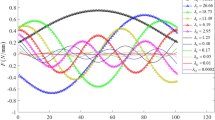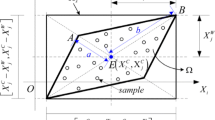Abstract
A new UBC-constrained (ultimate-bearing-capacity-constrained) non-probabilistic reliability-based optimization method for structures with uncertain-but-bounded parameters is proposed. Different from the traditional stress-constrained optimization, the ultimate bearing capacity (UBC) is taken as the constraints in the non-probabilistic reliability-based optimization, which reflect the system safety of structures. Based on the interval mathematics, the UBC constraint is transformed into the format of non-probabilistic reliability, in which a novel measuring index, namely, the UBC, is defined by an interval interference model. Thus, structural optimization is converted by the lightweight design problem with UBC reliability constraints. Moreover, the gradient-based Taylor expansion method is employed to obtain the lower and upper bounds of the UBC, which transforms a double-layer optimization into an efficient single-layer one. Finally, 2D and 3D structural examples are given to illustrate the effectiveness of the proposed method.
















Similar content being viewed by others
References
Adibi-Asl R, Seshadri R (2018) Variational method in limit load analysis—a review. J Pressure Vessel Technol 140:050804-050804-050813. https://doi.org/10.1115/1.4041058
Ben-Haim Y (1994) A non-probabilistic concept of reliability. Struct Saf 14:227–245. https://doi.org/10.1016/0167-4730(94)90013-2
Ben-Haim Y, Elishakoff I (1995) Discussion on: A non-probabilistic concept of reliability. Struct Saf 17:195–199
Ben-Haim Y, Elishakoff I (2013) Convex models of uncertainty in applied mechanics vol 25. Elsevier
Bhattacharjya S, Chakraborty S (2011) Robust optimization of structures subjected to stochastic earthquake with limited information on system parameter uncertainty. Engineering Optimization 43:1311–1330
Brooks SP, Morgan BJ (1995) Optimization using simulated annealing. Journal of the Royal Statistical Society: Series D (The Statistician) 44:241–257
Chen WF, Han DJ, Saunders H (1989) Tubular Members in Offshore Structures. J Vibration Acoust 111:496–498. https://doi.org/10.1115/1.3269893
Chen L, Liu Y, Yang P, Cen Z (2008) Limit analysis of structures containing flaws based on a modified elastic compensation method. Eur J Mech - A/Solids 27:195–209. https://doi.org/10.1016/j.euromechsol.2007.05.010
Dekkers A, Aarts E (1991) Global optimization and simulated annealing. Math Programm 50:367–393
Duan L, Chen W-F (1990) A yield surface equation for doubly symmetrical sections. Eng Struct 12:114–119. https://doi.org/10.1016/0141-0296(90)90016-L
Frangopol DM, Corotis RB (1996) Reliability-based structural system optimization: state-of-the-art versus state-of-the-practice. In: Cheng FY (ed). Analysis and computation: Proceedings of the 12th conference held in conjunction with structures congress XIV, 1996. p. 67–78
Freudenthal AM (1947) The safety of structures transactions of the American Society of Civil Engineers 112:125-159
Gendy AS, Saleeb AF (1993) Generalized yield surface representations in the elasto-plastic three-dimensional analysis of frames. Comput Struct 49:351–362. https://doi.org/10.1016/0045-7949(93)90114-S
Impollonia N, Muscolino G (2011) Interval analysis of structures with uncertain-but-bounded axial stiffness. Comput Method Appl M 200:1945–1962
Jiang C, Bai Y, Han X, Ning H (2010) An efficient reliability-based optimization method for uncertain structures based on non-probability interval model computers. Mater Continua (CMC) 18:21
Kang Z, Luo Y (2009) Non-probabilistic reliability-based topology optimization of geometrically nonlinear structures using convex models. Comput Method Appl M 198:3228–3238
Li Q, Qiu Z, Zhang X (2015) Static response analysis of structures with interval parameters using the second-order Taylor series expansion and the DCA for QB. Acta Mech Sin 31:845–854
Liu X, Da Q (1999) A satisfactory solution for interval number linear programming. J Syst Eng 14:123–128
Liu Y, Xu L, Grierson DE (2009) Combined MVP failure criterion for steel cross-sections. J Construct Steel Res 65:116–124. https://doi.org/10.1016/j.jcsr.2008.03.019
Luo Z, Wang X, Liu D (2020) Prediction on the static response of structures with large-scale uncertain-but-bounded parameters based on the adjoint sensitivity analysis. Struct Multidiscip O 61:123–139
Meng Z, Hu H, Zhou H (2018) Super parametric convex model and its application for non-probabilistic reliability-based design optimization. Appl Math Model 55:354–370
Mohareb M (2001) Exact yield hyper-surface for thin pipes. Int J Pressure Vessels Piping 78:507–514. https://doi.org/10.1016/S0308-0161(01)00059-X
Orbison JG, McGuire W, Abel JF (1982) Yield surface applications in nonlinear steel frame analysis. Comput Method Appl M 33:557–573. https://doi.org/10.1016/0045-7825(82)90122-0
Papadrakakis M, Lagaros ND (2002) Reliability-based structural optimization using neural networks and Monte Carlo simulation. Comput Method Appl M 191:3491–3507. https://doi.org/10.1016/S0045-7825(02)00287-6
Qiu Z, Wang L (2016) The need for introduction of non-probabilistic interval conceptions into structural analysis and design. Sci China Phys Mech:59. https://doi.org/10.1007/s11433-016-0329-3
Qiu Z, Huang R, Wang X, Qi W (2013) Structural reliability analysis and reliability-based design optimization: recent advances science China physics. Mech Astron 56:1611–1618
Schuëller GI, Jensen HA (2008) Computational methods in optimization considering uncertainties–an overview. Comput Method Appl M 198:2–13
Shi Q, Wang X, Chen W, Hu K (2020) Optimal sensor placement method considering the importance of structural performance degradation for the allowable loadings for damage identification. Appl Math Model
Suppapitnarm A, Seffen KA, Parks GT, Clarkson P (2000) A simulated annealing algorithm for multiobjective optimization. Engineering Optimization 33:59–85
Tong R, Wang X (1997) Simplified method based on the deformation theory for structural limit analysis—I. Theory and formulation International Journal of Pressure Vessels and Piping 70:43–49. https://doi.org/10.1016/S0308-0161(96)00045-2
Wang L, Liu Y (2020) A novel method of distributed dynamic load identification for aircraft structure considering multi-source uncertainties. Struct Multidiscip O:1–24
Wang X, Qiu Z, Elishakoff I (2008) Non-probabilistic set-theoretic model for structural safety measure. Acta Mech 198:51–64. https://doi.org/10.1007/s00707-007-0518-9
Wang XJ, Wang L, Qiu ZP (2012) Response analysis based on smallest interval-set of parameters for structures with uncertainty. Appl Math Mech-Engl 33:1153–1166. https://doi.org/10.1007/s10483-012-1612-6
Wang X, Li Y, Ma Z, Qiu Z (2016) Reliability-based optimization of the coupled structural-acoustic system with random parameters. International Journal of Acoustics and Vibrations 21:249–256
Wang C, Qiu Z, Xu M, Li Y (2017a) Mixed nonprobabilistic reliability-based optimization method for heat transfer system with fuzzy and interval parameters. IEEE Trans Reliabil 66:630–640
Wang L, Liu D, Yang Y, Wang X, Qiu Z (2017b) A novel method of non-probabilistic reliability-based topology optimization corresponding to continuum structures with unknown but bounded uncertainties. Comput Method Appl M 326:573–595
Wang L, Wang X, Li Y, Hu J (2019a) A non-probabilistic time-variant reliable control method for structural vibration suppression problems with interval uncertainties. Mech Syst Signal Process 115:301–322
Wang X, Ren Q, Chen W, Liu Y, Wang L, Ding X (2019b) Structural design optimization based on the moving baseline strategy. Acta Mech Solida Sin:1–20
Wang X, Shi Q, Fan W, Wang R, Wang L (2019c) Comparison of the reliability-based and safety factor methods for structural design. Appl Math Model 72:68–84
Xu M, Du J, Wang C, Li Y (2017) A dimension-wise analysis method for the structural-acoustic system with interval parameters. J Sound Vib 394:418–433
Yang YB, Fan HT (1988) Yield surface modeling of I-sections with nonuniform torsion. J Eng Mech 114:953–972. https://doi.org/10.1061/(ASCE)0733-9399(1988)114:6(953)
Yang Q, Cheng Y, Zhao Y, Zhou W-y (2004) Limit analysis method based on nonlinear programming and its application. Eng Mech 2:002
Yang L, Yu B, Qiao Y (2009) Elastic modulus reduction method for limit load evaluation of frame structures. Acta Mech Solida Sin 22:109–115. https://doi.org/10.1016/S0894-9166(09)60095-1
Yang LF, Yu B, Ju JW (2012) System reliability analysis of spatial variance frames based on random field and stochastic elastic modulus reduction method. Acta Mech 223:109–124. https://doi.org/10.1007/s00707-011-0546-3
Yang L, Li Q, Zhang W, Wu W, Lin Y (2014) Homogeneous generalized yield criterion based elastic modulus reduction method for limit analysis of thin-walled structures with angle steel. Thin Wall Struct 80:153–158
Yang L, Liu J, Yu B, Ju J (2017) Failure path-independent methodology for structural damage evolution and failure mode analysis of framed structures. Int J Damage Mech 26:274–292
Yao W, Chen X, Luo W, Van Tooren M, Guo J (2011) Review of uncertainty-based multidisciplinary design optimization methods for aerospace vehicles. Progress Aerospace Sci 47:450–479
Zhou SP, Chen WF (1985) Design criteria for box columns under biaxial loading. J Struct Eng 111:2643–2658. https://doi.org/10.1061/(ASCE)0733-9445(1985)111:12(2643)
Zhou Q, Wang Y, Choi S-K, Jiang P, Shao X, Hu J, Shu L (2018) A robust optimization approach based on multi-fidelity metamodel. Struct Multidiscip O 57:775–797
Funding
The work of this article is supported by the National Nature Science Foundation of China (No. 11872089) and the Defense Industrial Technology Development Program (Nos. JCKY2017601B001, JCKY2017208B001, and JCKY2019203A003).
Author information
Authors and Affiliations
Corresponding author
Ethics declarations
Conflict of interest
The authors declare that they have no conflict of interest.
Replication of results
The raw data required to reproduce these findings are available to download from DOI: https://doi.org/10.17632/xbvw9g78gr.1
Additional information
Responsible Editor: Byeng D Youn
Publisher’s note
Springer Nature remains neutral with regard to jurisdictional claims in published maps and institutional affiliations.
Appendix
Appendix
Structural components may have different cross-section shapes, and the expressions of the full plastic force of different cross sections are different. The full plastic force of five common cross sections (shown in Fig. 17) is given in this appendix. The full plastic force of the five cross-section shapes is shown in Eqs. 41 ~ 45, respectively. In these equations, NPx, MPy, and MPz are full plastic axial forces, bending moment in y and z direction, respectively.
-
(1)
Rectangle cross section
-
(2)
Circular cross section
-
(3)
I-shaped cross section
where λ presents the ratio of the area of flange Af and the area of web Aw, i.e., λ = Af/Aw.
-
(4)
Rectangle hollow cross section
-
(5)
Circular hollow cross section
Rights and permissions
About this article
Cite this article
Luo, Z., Wang, X., Shi, Q. et al. UBC-constrained non-probabilistic reliability-based optimization of structures with uncertain-but-bounded parameters. Struct Multidisc Optim 63, 311–326 (2021). https://doi.org/10.1007/s00158-020-02697-y
Received:
Revised:
Accepted:
Published:
Issue Date:
DOI: https://doi.org/10.1007/s00158-020-02697-y





